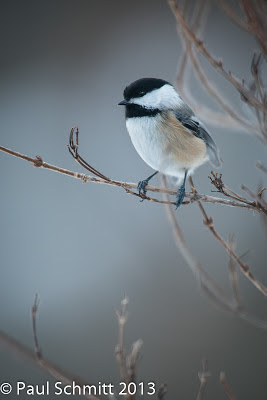Less than an hour from home is the tallest single-drop falls in the eastern United States- Taughannock Falls. It's a 215 feet drop. It is one of the few waterfalls that can be safely approached in winter. This is how my iPhone4 recorded a cold morning below the falls.
(Technical note: iPhone 4, Pro HDR app, tripod with Joby tripod adapter)
I have also been fascinated with the tones that are revealed when converting the images to monochrome (black and white) images. The above scene depicts those cold but sunny winter days with a blue sky contrasted by the shaded gorge in subtle colors including green, or all things. Going to monochome creates a different response if the blue is filtered to darken it.
Now it looks cold and stormy. I've explored this scene in some detail with my Nikon D800, and find some images are more effective with a slight bit of color.
I feel a chill when I look at this image of a small part of the falls. My mind fills with a replay of the subtle hiss of the falls. At the same time, some of the scenes in monochrome have a pure feeling like this one.
I think the monochrome above captures the contrast of the hard, immoveable ice against a streaming ribbon of falling water flashing into a mist of ice crystals.
One inner voice says to me that winter is the one time of the year when monochrome works consistently, so just forget the color until spring comes along. Another voice says no, you've got color, use it. Maybe you, the viewer, can help me? Your initial reaction is something I cannot capture myself after looking at these so much. Obviously, I cannot keep showing two versions of the same photo. That becomes boring.
At left is a color rendering of the falls with the light blue and green tones that are found naturally. I like the sense of cold that it conveys. I've set the white on the clean show in the upper left corner.
At the right is the same photo processed into monochrome. I like
it also. I see more of the forms in the ice and the falling water. The stream of water seems to have more power.
There is my conflict. Which to show? I've looked at these so
much that I cannot capture the initial response of a first time viewer.
Which works best for you? ... or is it a matter of which works best
for different scenes? I welcome any comments on how you first react to
these. They will be sincerely appreciated.
Now, I am also experimenting with another way to look at falling water and ice. At another little waterfall after dark, I illuminated the totally frozen drop with a blue gel filter on a flashlight. What could make the scene seem any colder than blue light? It was, in fact, brutally cold on my first trial of this method. A little bit of moonlight came in to make it easier to see what I was doing.
I'll be back at this lovely little falls when there is a little more flowing water to see what more can be discovered.
Yes, I've fallen in love with ice's elegant forms and its ability to convey a beautiful side of winter.














